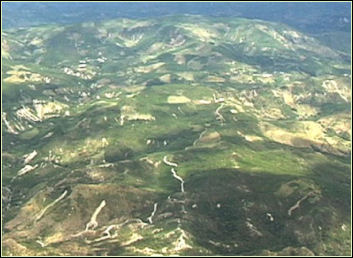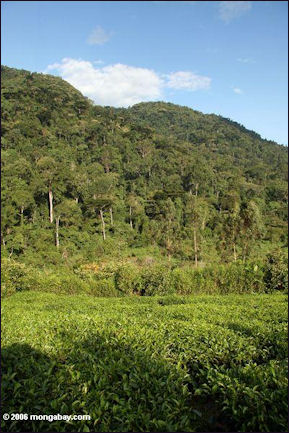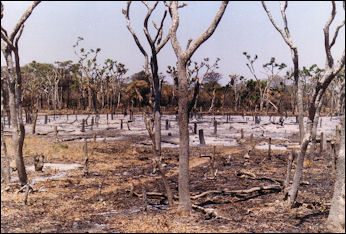CAUSES OF DEFORESTATION
Natural deforestation caused by
Hurricane Mitch in Central America
Logging, mining and roads have all played a part in the destruction of rainforests. But by most estimates over 75 percent of all tropical rainforest deforestation has been the result of ranching, and plantation and slash and burn agriculture.
Researchers with Rainforest Foundation Norway, according to to CBS News, “blame "human consumption" for the loss. While agriculture has always been a driving factor of rainforest loss, the report said that energy consumption, international trade and the production of soy, palm oil, cattle, logging and mining have been the largest threats over the past century. A significant amount of U.S. commodities rely on resources from tropical rainforests. The country heavily relies on palm oil, rubber and cocoa, all of which come from forests around the world. Oftentimes, these resources are harvested from illegally deforested lands. [Source: Li Cohen, CBS News, March 10, 2021]
Henry Fountain wrote in the New York Times: According to to World Resources Institute “most forest loss in the tropics was driven by agriculture, either the production of commodities like palm oil and cocoa or subsistence efforts by small farmers. In either case, forests are usually clear-cut and the resulting debris is burned to prepare the fields. Often these fires can grow out of control, resulting in greater forest loss, and the warming and drying brought on by climate change can make the situation even worse.” [Source: Henry Fountain, New York Times, March 31, 2021]
See Separate Articles: RAINFOREST DEFORESTATION: RATES, RESULTS AND ALARM factsanddetails.com; AMAZON DEFORESTATION factsanddetails.com; PEOPLE IN THE RAINFOREST: INDIGENOUS TRIBES, SETTLERS AND SLASH-AND-BURN AGRICULTURE factsanddetails.com; RAINFOREST LUMBER AND TIMBER AND PAPER COMPANIES factsanddetails.com PALM OIL AND RAIN FOREST DEFORESTION factsanddetails.com; PALM OIL: USES, HISTORY, AGRICULTURE AND PRODUCTION factsanddetails.com; COMBATING DEFORESTATION AND EFFORTS TO SAVE THE RAINFOREST factsanddetails.com; NEW JUNGLES AND REFORESTATION factsanddetails.com
Burning the Rainforest
The burning of the rainforest has been compared with the burning of the ancient library in Alexandria. A veteran botanist once said: "The rainforest is the very core of the biology of this planet." Some rainforest fires are triggered accidently by careless fires or ignited by lightning but many are set off intentionally.
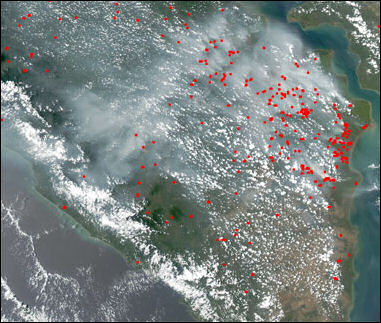
Fires in Sumatra
Most of the fires are set by farmers clearing the land for crops or ranchers burning off grasses to bring up tender shoots for their animals to feed on. At the end of the dry season, especially after a prolonged drought, these fires can spread to the forest and burn out of control.
Many severe fires get started as brush fires and build up enough heat to set the trees on fire, beginning with the small trees. If the brush is burned off there is not enough material to get the fire going and the big trees are large and tough enough to withstand catching on fire from limited fires. In the United States, fires have been stopped with patches of forest that have been selectively logged and had their brush burned off.
A study by Oregon University found that after a fire new seedlings are more likely to take root and the forest recover if trees are left standing and timber is not cleared away. The study found that seedlings grow even in severely burned areas but often die when trees are cut down and hauled away. In addition, material left from cutting down trees is more likely to fuel future fires than trees left untouched after a fire.
Logging, See Timber, Separate Article
Cattle and Beef: Major Causes of Rainforest Deforestation
A study by World Resources Institute (WRI) in 2021 blamed beef for much of the world’s rainforest deforestation. Quartz reported: “WRI looked at global satellite imagery between 2000 and 2015. It found seven commodities accounted for 72 million hectares of lost forest, an area double the size of Germany. Of that, cattle ranching is responsible for 16 percent of total tree cover loss, or 45.1 million hectares, an area roughly equal to Sweden. It is followed by palm oil (10.5 million hectares) and soy (7.9 million hectares). The reportedly said seven commodities accounted for 57 percent of all deforestation from agriculture. [Source: Michael J. Coren, Quartz, February 13, 2021]
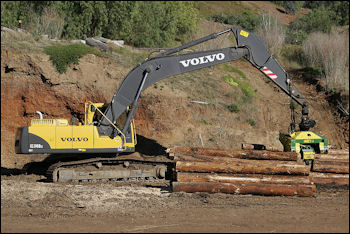
logging According to the WRI: We did not see any noticeable changes in the rate at which cattle pasture replaced forestssince 2001, despite a number of zero-deforestation commitments. Deforestation from cattle is much harder to tackle from within supply chains, because pasture expansion happens in some places despite very low or even negative profit margins. In those cases, landholders may convert forests to pasture as a form of land speculation, to secure land tenure, or for social and cultural reasons rather than for profit. Beef consumption also tends to be more domestic; only around a quarter of beef produced in Brazil is exported. This makes beef supply chains less responsive to international pressure around reducing deforestation. [Source: Mikaela Weisse and Elizabeth Dow Goldman, World Resources Institute, February 11, 2021]
Especially in the Americas large swaths of rainforest have been cut down to make way for cattle ranches. In Brazil in the 1980s they were cut down for cattle ranches that weren't even profitable. The ranchers cleared the forests for tax credits and low interest loans backed up by the World Bank. Reacting to criticism the Brazilian government and the World Bank ended most of those credits and loans. Afterwards many of the cattle ranches failed and the pastures were reclaimed by secondary growth. For a while most tropically grown beef ended in fast food hamburgers, microwave meals or in cat and dog food. McDonald’s was singled out as a major villain.
According to the Washington Post: “The Amazon is the world's largest rainforest and arguably the most closely watched harbinger of deforestation. The rainforest is 17 percent deforested, and losses are especially pronounced in Brazil, which lost some 1.7 million hectares of rainforest in 2020 alone. "If you're looking at the area cleared, Brazil is usually the worst," Nathalie Walker, the director of tropical forest and agriculture at the National Wildlife Federation, said. And of that, "cattle is the single biggest driver" of loss. [Source: Tik Root and Harry Stevens, Washington Post, November 4, 2021]
Cash Crops, Plantation Agriculture and Deforestation
tea plantation in UgandaLarge tracts of rainforest have been cleared for cash crops such as tea, coffee, tobacco, sugar, rubber, cotton and palm oil. Governments have often provided funding for large projects operated by large multinational corporations. There are also large tree plantations for paper and wood with mahogany, teak and fast-growing trees such as pine and eucalyptus.
Now the rain forest is being felled by “industrial forestry, agriculture, the oil and gas industry — and it’s globalized, where every stick of timber is being cut in Congo is sent to China and one bulldozer does a lot more damage than 1,000 farmers with machetes,” Bill Laurance, a senior scientist at the Smithsonian, who has worked extensively in the Amazon, told the New York Times.
According to the WRI: As demand for food and other resources continues to grow, forests are often cleared to make way for new fields and plantations. Scientists estimate that over a quarter of tropical forests and just under half of temperate forests have been converted to production in human history. Today, the majority of tree cover loss associated with the expansion of farms and plantations happens in the tropics, a troubling trend considering the vast carbon stocks and biodiversity held in rainforests.
Oil palm replaced forests mostly in Indonesia and Malaysia, while soy replaced forests mainly in South American countries like Brazil and Argentina. The conversion of forests to cattle pasture was more widely distributed across the globe, but hotspots exist in South and Central America. Cocoa, rubber, wood fiber and coffee played a big role in replacing forests in some countries, despite their smaller global impacts. In Ghana, for example, conversion of forests to cocoa represents a third of the country’s total tree cover loss.
Seven Commodities Deforestated an Area Twice the Size of Germany in 15 Years
An analysis by the World Resources Institute (WRI) in 2021 showed that just seven agricultural commodities — cattle, oil palm, soy, cocoa, rubber, coffee and plantation wood fiber — accounted for 26 percent of global tree cover loss from 2001 to 2015. These agricultural commodities replaced 71,900 square kilometers, (277,607 square miles) during that period, an area of land more than twice the size of Germany. [Source: Mikaela Weisse and Elizabeth Dow Goldman, World Resources Institute, February 11, 2021]
According to the WRI: Our analysis compares the current extent of seven commodities with annual tree cover loss data from 2001 to 2015 to map where each commodity replaced forests over that time span. Of the seven agricultural commodities, cattle pasture replaced the most forest by far — 45.1 million hectares, or an area of land the size of Sweden. Cattle are responsible for 16 percent of total tree cover loss. Oil palm is a distant second, replacing 10.5 million hectares from 2001 to 2015, while soy accounted for 7.9 million hectares. Cocoa, plantation rubber, plantation wood fiber and coffee each replaced around 2 million hectares of forest from 2001 to 2015, though the analyses for rubber and wood fiber cover only a subset of countries because of data availability. [Source: Mikaela Weisse and Elizabeth Dow Goldman, World Resources Institute, February 11, 2021]
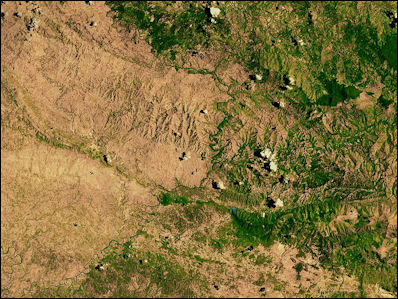
Haiti deforestation and erosionThe seven commodities analyzed represent 57 percent of agriculture-related tree cover loss from 2001-2015. The rate at which oil palm plantations replaced forests dropped sharply after 2012. Other studies attributed this to drops in palm oil prices, national policies intended to curb forest clearing and corporate zero-deforestation commitments. Although the study period ends in 2015, Indonesia — the country accounting for two-thirds of forests replaced by oil palm — saw three consecutive years of reductions in primary forest loss from 2017-2019.
The rate at which soy replaced forests dropped dramatically after a spike in 2004. As with oil palm, the drop coincided with lower prices, new national policies and deforestation-free supply chain initiatives. Since then, the rate at which soy replaced forests rebounded in Brazil’s Cerrado through 2012, but then declined slightly from 2013-2015. With primary forest loss increasing since 2015 in Brazil, the country where soy has replaced the most forest, it remains to be seen whether those declines will continue.
Although data on plantation wood fiber and rubber is more limited than other commodities, the analysis also shows some recent declines in the rate at which such plantations replaced forests. These correspond with a decline in prices for rubber and zero-deforestation commitments for most large wood fiber companies.
Other agricultural commodities showing limited progress in reducing deforestation are cocoa and coffee, though detailed maps of cocoa and coffee are difficult to produce, as these commodities are often grown under canopy cover and are hard to see in satellite imagery. We’ve seen fluctuations in recent years in the rates of primary forest loss in the big cocoa-producing countries of Ghana and Cote d’Ivoire. Better data sets on the footprint of cocoa production could greatly improve our understanding of how much those fluctuations are related to cocoa.
We are still a long way from fully understanding the complex dynamics between agricultural commodity production and deforestation. For example, the analysis can’t prove that land was deforested because of any one crop, only that the crop was planted in an area that was deforested. We also aren’t able to account for the indirect impacts that commodities may have on each other and the world’s forests, such as when the expansion of one crop displaces another into forests or drives up land values.
Illegal Logging and the Rainforest
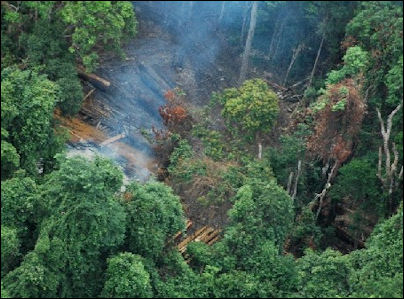
logging in Cambodia Illegal logging is a serious problem in many places, particularly Indonesia, Cambodia and some parts of Africa. The loggers, often employed by rogue companies, cut down trees in violation of national conservation laws and outside the control of governments.
According to the New York Times, “Vast swaths of rain forest continue to vanish every year, much of it through illegal timber operations. And problems persist in legally sanctioned logging as well, as producers bribe officials to allow overharvesting, submit false data to the authorities on the type of trees being logged or otherwise skirt the law. “The illegal issuance of licenses is part of the problem that’s been addressed relatively little,” Sam Lawson, a researcher with Chatham House, told the New York Times. [Source: John Collins Rudolf, New York Times]
Illegal logging is often just as likely to take place in national parks as it is to take place anywhere else. The wood is often smuggled to another country, ultimately making its way to developed countries. In addition to destroying rainforests and causing deforestation, it deprives developing countries of an estimated $18 billion annually in lost revenues.
According to a World Wide Fund report the European Union is contributing to the destruction of the rainforest in Africa, Asia and Latin America by purchasing illegally logged timber, much of via China. The report said Britain was “the biggest importer of illegal timber” in Europe accounting for the loss of 600,000 hectares — more than twice the size of Luxembourg — a year. Finland, Germany, France, Italy and the Netherlands were also major purchasers.
Illegal logging is also devastating in that it floods the market with cheap timber imports, which hurts domestic lumber markets and forest management in the countries that import the timber, which increases demand for imports.
“Illegal logging” remains a somewhat nebulous term in many producer countries because of weak or limited regulations. The American Forest and Paper Association estimates that illegal logging costs the U.S. timber and wood products industry $1 billion a year. America’s grade lumber exports have soared in recent years as overseas suppliers look for hardwood products that can reenter the United States without a problem. [Source: Juliet Eilperin, Washington Post November 13, 2011]
Ranchers and Drug Barons Threaten Rain Forest in Guatemala
Reporting from El Mirador, Guatemala, Blake Schmidt wrote in the New York Times, Great sweeps of Guatemalan rain forest, once the cradle of one of the world’s great civilizations, are being razed to clear land for cattle-ranching drug barons.Other parts of the Maya Biosphere Reserve, Central America’s largest protected area, have been burned down by small cities of squatters. Looters and poachers, kept at bay when guerrilla armies roamed the region during the country’s 36-year civil war, ply their trades freely. [Source: Blake Schmidt, New York Times, July 17, 2010]
“There’s traffickers, cattle ranchers, loggers, poachers and looters,” Richard D. Hansen, an American archaeologist, told the New York Times. “All the bad guys are lined up to destroy the reserve. You can’t imagine the devastation that is happening.” Hansen is leading the excavation of the earliest and largest Mayan city-state, El Mirador, in the northern tip of the reserve.
The reserve, about the size of New Jersey, accounts for nearly two-thirds of the Petén region, a vast, jungly no man’s land that juts north into Mexico and borders Belize to the east. Spanning a fifth of Guatemala and including four national parks, the reserve houses diverse ecosystems with niches for jaguars, spider monkeys and scarlet macaws. Pre-Colombian inhabitants mined limestone quarries here 2,600 years ago to build the earliest Mayan temples. The temples would tower above the jungle canopy before the cities were abandoned as Mayan civilization mysteriously collapsed around the ninth century A.D.
The threats to the reserve are many and interlocking, legal and illegal. Claudia Mariela López, the Petén director for the national parks agency, said about 37,000 acres of the reserve was deforested annually by poachers, squatters and ranchers. The squatters are mainly peasants who have come in search of farmland. But the population of Petén has grown to more than 500,000 from 25,000 in the 1970s, according to a UNESCO report. Not all of the residents are illegal, and many seek no more than subsistence.
Willingly or not, they often become pawns of the drug lords. The squatters are numerous, frequently armed and difficult to evict. In some cases, they function as an advance guard for the drug dealers, preventing the authorities from entering, warning of intrusions and clearing land that the drug gangs ultimately take over.
Deforestation, Economics and Corruption
Rising food prices have been bad news for rainforests as farmers have more incentive than ever to chop down forests and plant cash crops. By some estimates already 4.5 million acres in conservation areas is being farmed.
The economic downturn in 2008 and 2009 was a blessing for rainforests. In Brazil, where cattle grazing is a leading cause of Amazon deforestation, falling beef prices and shortages of farm credit caused rates of deforestation to fall 70 percent.
According to the World Resources Institute perhaps the greatest threat to the rainforest is corruption and politics. The group’s president, Jonathan Lash, told the Independent, “Much of the threats facing the remaining intact forests boil down to bad economics, bad management and corruption. Much of the corruption occurs on the local level.
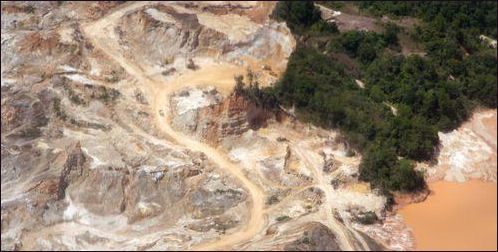
gold mine
Image Source: Mongabay mongabay.com ; Wikimedia Commons
Text Sources: “The Private Life of Plants: A Natural History of Plant Behavior” by David Attenborough (Princeton University Press, 1997); New York Times, Washington Post, Los Angeles Times, Times of London, Lonely Planet Guides, Library of Congress, Malaysia Tourism Promotion Board, Compton’s Encyclopedia, The Guardian, National Geographic, Smithsonian magazine, The New Yorker, Time, Newsweek, Reuters, AP, AFP, Wall Street Journal, The Atlantic Monthly, The Economist, Foreign Policy, Wikipedia, BBC, CNN, and various books, websites and other publications.
Last updated April 2022

